After Round One of this year’s Guinness Six Nations saw three away wins there was a sense of normal service resumed in Round Two as the home crowds in Dublin, Edinburgh and London were treated to victory. Two nations kept up their 100% records along with their Grand Slam hopes, while two are still looking for a first win to banish Wooden Spoon fears.
The editors at OptaJonny cast their eyes over the weekend’s action…
Ireland 32-19 France
Ireland and France kicked off the weekend in style as the crowd at the Aviva Stadium were treated to a thriller, with the top two sides in the world slogging it out in Dublin. Andy Farrell’s men came into the match aiming to record a 13th consecutive home victory, while Les Bleus themselves were on a record 14-game winning run.
Ultimately it was Ireland who secured a bonus-point victory – only the third time they’ve scored four tries in a match against France in the Six Nations after 2006 (a match they lost) and 2019. Although the scoreline gave the impression of a comprehensive win – it was Ireland’s biggest against France in the Five or Six Nations since a 25-6 win in 1975 – the game was firmly in the balance for most of the 80 minutes.
The basic match stats paint a picture of a game that was closer than the score suggested too, perhaps even a match that you might guess Les Bleus had won. Ireland made more carries than France, but Les Bleus recorded a higher average gain, beat more defenders and recorded a far higher tackle success rate than Ireland.
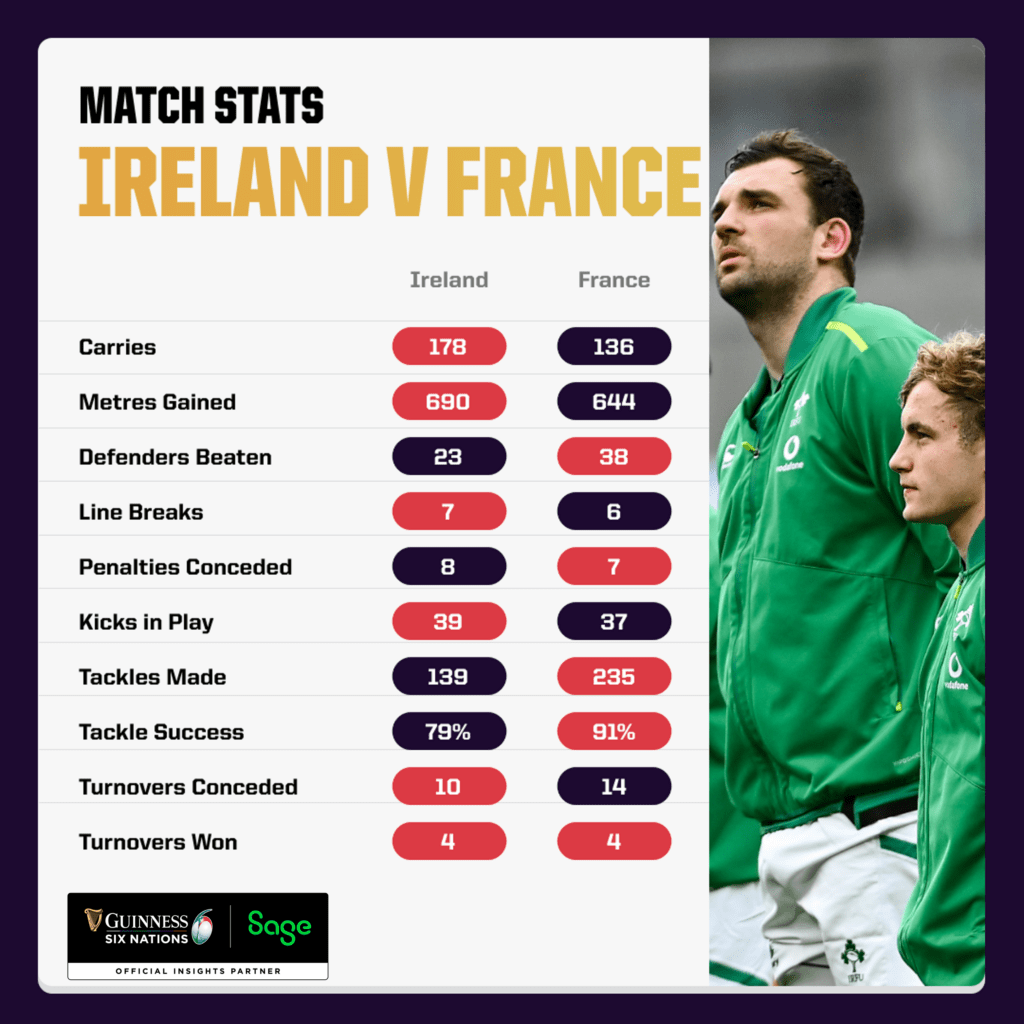
If we dive deeper into some of those basic stats though, we can see where Ireland managed to get the edge. While they put boot to ball a similar number of times, Ireland retained possession from a higher percentage of their kicks. It was a similar story with line breaks, Andy Farrell’s men made just one more than France but were more clinical, scoring from 43% of their breaks. This was backed up in their 22 entry numbers as Ireland not only made more 22 entries but averaged more points per entry than France.
They edged the breakdown too – 65% of their rucks were completed within three seconds while a staggering 41% saw the ball available in under two seconds. France may have contributed to this by committing two or more players to just 6% of Ireland’s attacking rucks and while it helped keep more men in the defensive line and increase their tackle success rate, it meant that Ireland’s waves of attack were relentless and ultimately broke down the blue wall.
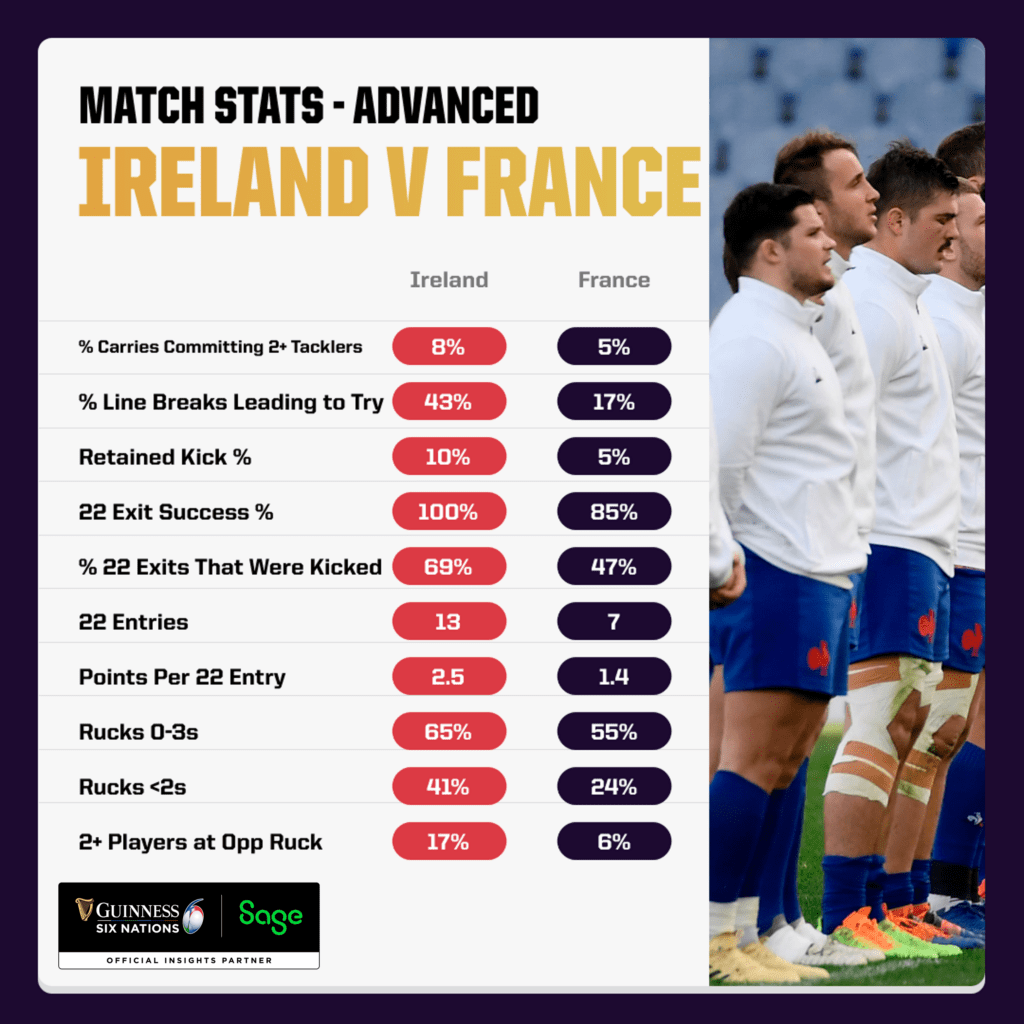
It was a fantastic game and one factor that helped was a ball-in-play time of 46:10, the highest in a Test involving a Tier 1 nation since England vs. Wales in the 2018 Six Nations (47:46). This was despite there being 76 kicks in the match, over 20 more than any other fixture over the weekend. That said, 86% of those kicks were kept in field, also the highest rate of any game in Round Two.
On top of the kicking battle, both teams showed real intent when they attacked and at times the game was end-to-end. Ireland gained 690 metres, their fifth most in a Six Nations match, while France gained 644 – their most in the Championship since 2017 (856 vs. Italy) and their most against Ireland since their first meeting back in 2000 (707). In fact, the 1334 metres gained in total in the game was the second most ever in a Six Nations fixture after England and France’s Super Saturday clash in the final round in 2015 (1359).
It was a modern classic and a shame that only one side could come out on top. But it is Andy Farrell’s men who will go into Round Three with their Grand Slam hopes still alive.
Scotland 35-7 Wales
There was a sense of déjà vu coming into this match, with Scotland having beaten England in the opening round of the Guinness Six Nations for the third year in a row before coming up against Wales in Round Two. Thankfully for Scotland fans that was where the similarities ended. In 2021 and 2022 the men in red brought Gregor Townsend’s side back down to earth, but in Edinburgh on Saturday Scotland recorded a resounding win that has given them genuine ambitions of a first title since the 1999 Five Nations. Welsh defeat has left Warren Gatland with plenty to think about for the next two weeks before welcoming England to Cardiff.
It was Scotland’s biggest-ever victory against Wales in their Test history and the first time the Scots had won their opening two matches of a Six Nations campaign since Italy joined the Championship in 2000. Prior to this game, they’d won their opening game five times at the Championship, before suffering defeat one week later.
There is no doubt that Scotland have been the most clinical team in the Six Nations so far in 2023. Townsend’s men have taken almost every opportunity they’ve created in their opening two matches. Against England in Round One they averaged 4.1 points per 22 entries before averaging exactly four points per entry against Wales at the weekend. Those two tallies are higher than any other team has managed in a game so far in this year’s Championship. In fact, Ireland (3.4 vs. Wales) are the only team to average 3+ points per 22 entry in any of their opening two fixtures.
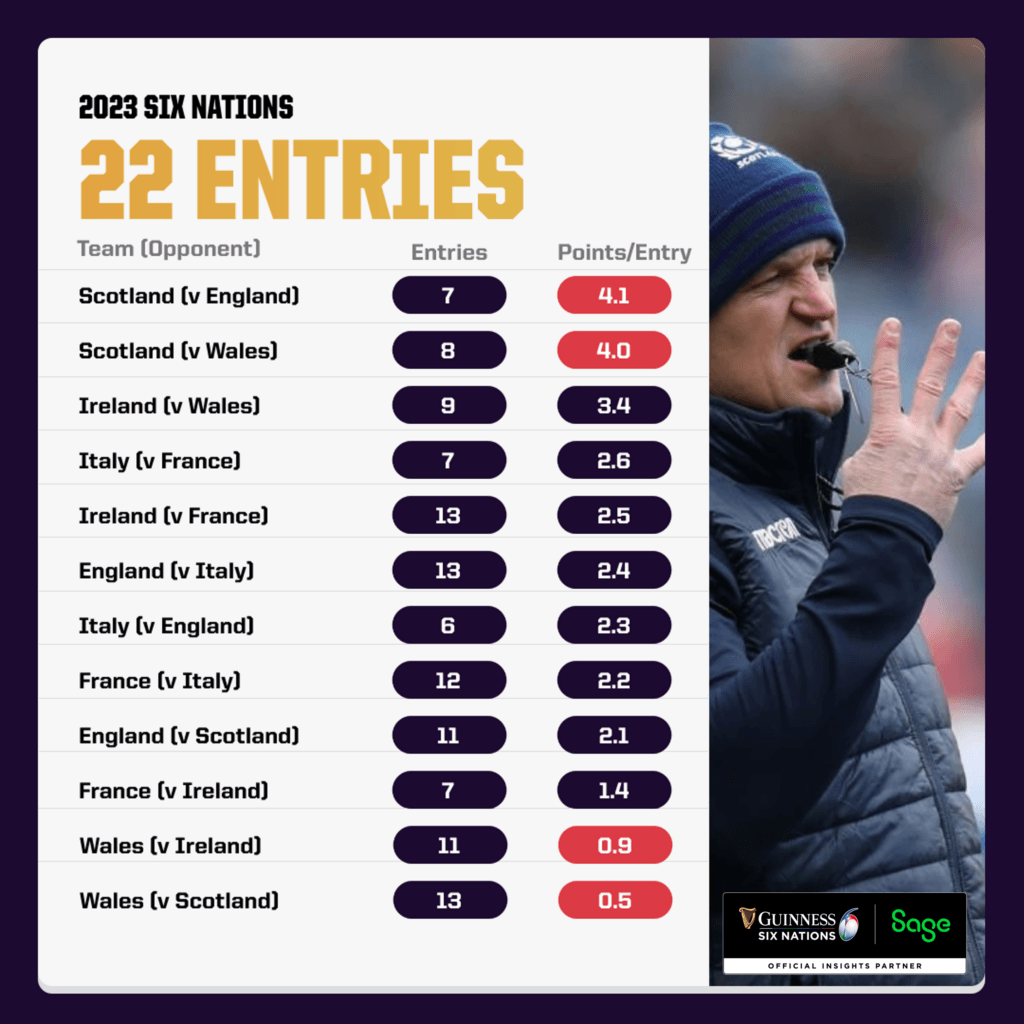
Wales have suffered from the opposite issue. They’ve failed to average more than one point per entry in any of their opening two matches, with their tally against Scotland the lowest of any team after two matches.
Perhaps the most disappointing thing is that defensively they didn’t make Scotland work hard enough for their scores, with Townsend’s side only stringing together five or more phases on four occasions during the match – that accounted for just 6.9% of their overall possessions, by far the lowest rate of any team at the weekend. However, Scotland didn’t need more than five phases to break down Wales, with all five of their tries coming in four phases or fewer. Meanwhile, Wales hit five-plus phases on 23% of their possessions but rarely troubled Scotland before eventually turning the ball over.
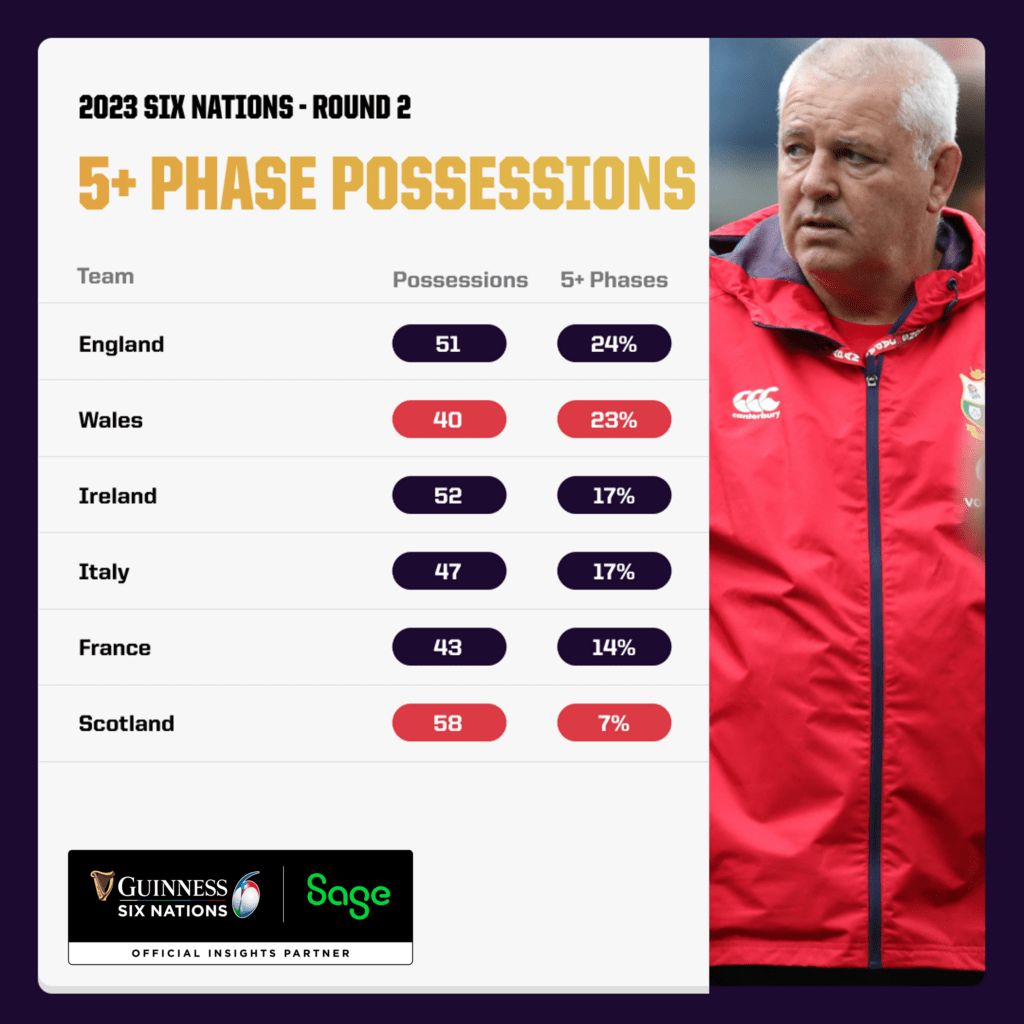
It helps when you have a magician on your team like Finn Russell though. The Bath-bound No. 10 pulled the strings for Scotland, recorded a hat-trick of try assists in the Six Nations in the process, and became the first Scottish player to manage that feat. Russell now has 10 try assists since the beginning of 2022, as well as a further nine line-break assists, the most of any Tier 1 player in either category. Scotland will travel to France in Round Three, one of the most difficult places to win, but they’ve managed it under Gregor Townsend before and with a player capable of unlocking any defence in their ranks, they won’t fear Les Bleus.
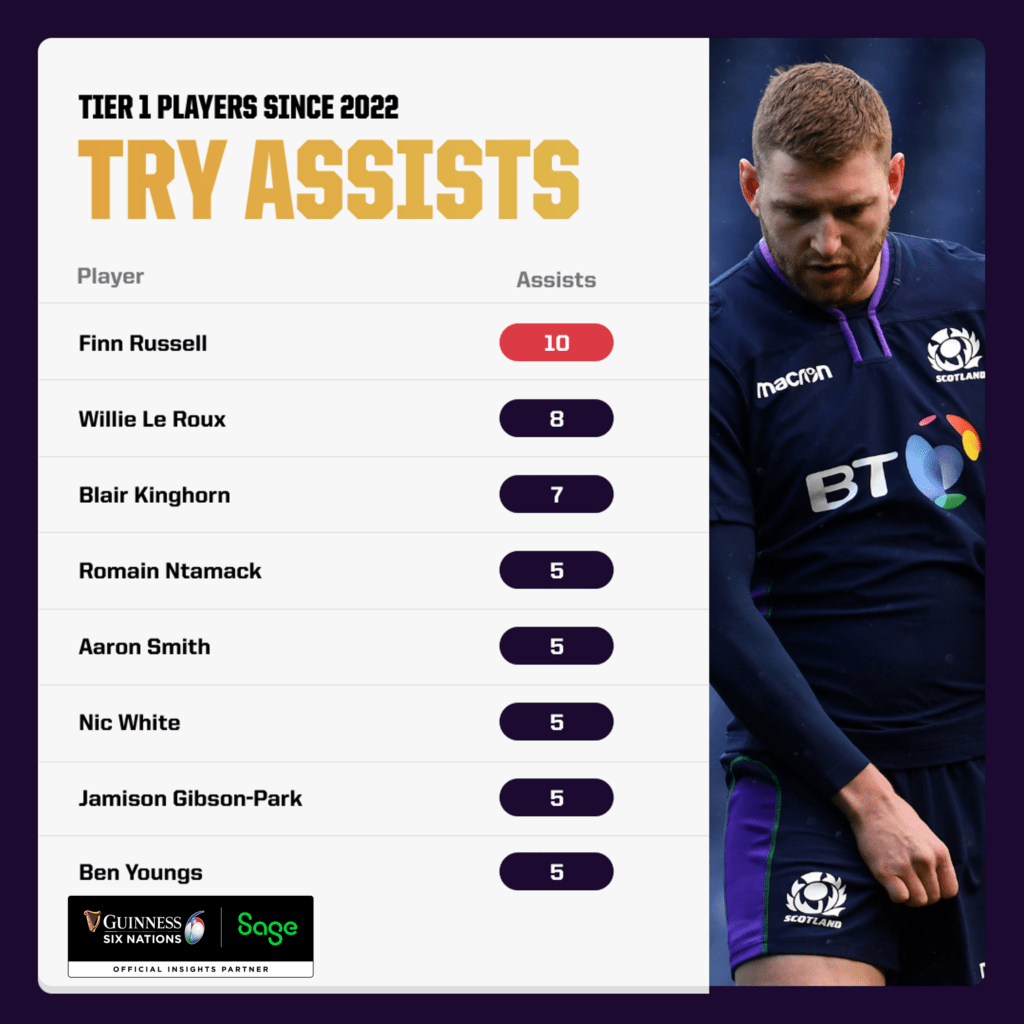

England 31- 14 Italy
After disappointment in a tightly fought Calcutta Cup match in week 1, Steve Borthwick picked up the first win of his fledgling career as England boss with a slightly staccato victory against Italy. The Italians had run France close in their opener and were a potential banana skin for England, but the hosts relieved any pressure with a dominant first half which saw them lead 19-0. Although England had control of the match and the scoreboard, there were periods when the Azzurri looked worryingly threatening with the ball in hand, something which will have frustrated defence coach Kevin Sinfield, especially in the second period. Across the 80 minutes, Italy beat 41 defenders (13 in the first half, 28 in the second half), or put another way, England missed 41 tackles. It was Italy’s best figure in this category in a Six Nations match (previous best 29 vs. Scotland last year) and conversely, it was the most tackles England had missed in a game in the Championship.

Another theme of England’s performance was their tactical kicking and some of their decision making in the final stages of attack.
With a shuffle of the cards in midfield and Owen Farrell returning to fly-half, it was a fresh combination with Jack van Poortvliet at scrum-half and Henry Slade and Ollie Lawrence outside them. Communication looked understandably disjointed at times and whether it was a by-product of that confusion or a pre-game tactic, England decided to kick the ball from dangerous positions on numerous occasions. In fact, they used low/grubber kicks seven times in the match, something they did six times against Scotland also, the most any side has employed this niche tactic since 2020 in the Championship.

The 2023 Guinness Six Nations feels like one of the most competitive editions of the Championship for a long time and undoubtedly teams need to be creative in finding solutions to break down the opposition. England have plenty of options in their armoury: a dynamic back-row, a creative but hard carrying midfield and plenty of pace and strength out wide, not to mention some bulldozers in the tight five. So, whether the option of delicate kicks in behind is one that will continue will no doubt be up for debate, as they face the challenges of Wales next up then two huge games against France and then Ireland.
Talking briefly of that creative but hard carrying midfield. Ollie Lawrence deserves special mention for a standout performance. The Bath centre picked up the Player of the Match award and justifiably so. He beat eight defenders, the most any England centre has managed in a Six Nations match and in fact, a tally only five other centres from any side have managed in the Championship’s 23-year history (Brian O’Driscoll, Emile N’tamack, Damien Traille, Sam Johnson, Nick Tompkins).
Enjoy this? Subscribe to our newsletter to receive five stories each Friday. It’s free. Also, follow us on Twitter.
